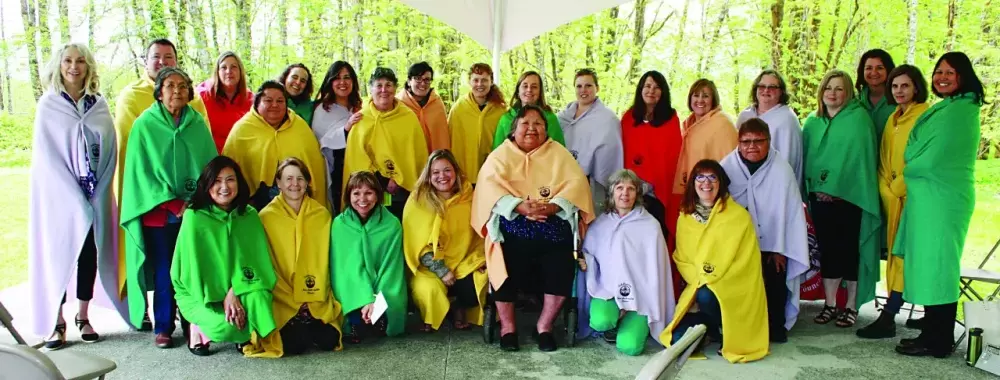Nuu-chah-nulth nations have furthered the understanding of culturally appropriate and respectful health care, building on a knowledge base that could provide a model for other Indigenous populations.
People in Ka:'yu:'k't'h'/Che:k'tles7et'h', Ditidaht, Ahousaht and Hesquiaht communities have been taking part in learning circles for the past couple of years, providing valuable input into a health services research project called Nursing the Nuu-chah-nulth Way.
Principal investigator in the project, Lisa Bourque-Bearskin, is an associate professor in the school of nursing at Thompson Rivers University in Kamloops. She said the research should benefit Nuu-chah-nulth and other Indigenous communities, particularly remote and northern ones.
“What does traditional wellness mean to them and how does that reduce disparities and improve access to health care,” said Bourque-Bearskin, explaining her line of inquiry.
Why nursing in particular? When she looked at Indigenous health-care providers, the researcher found that 77 percent are nurses.
“When we talk about transforming the health-care system … they need to be leading this work,” said Bourque-Bearskin. “They need to be front and centre so that they can practice without fear of retribution.”
A grant from the Michael Smith Foundation for Health Research enabled the project to start three years ago. Ehattesaht, Nuchatlaht and Huu-ay-aht are also partners.
Jeannette Watts, NTC manager of nursing services, sees the research as a continuation of a journey begun 30 years ago when responsibility for health services was transferred from Health Canada to NTC, the first transfer of health responsibilities to a tribal council in Canada. Along with that came a nursing framework and the nations’ health plans.
“This research is going to just deepen the value of that approach to nursing,” Watts said. “I think what’s important in this is that Nuu-chah-nulth people have the right to uphold the traditional practices of the community using their own knowledge.”
Bourque-Bearskin, a member of the Beaver Lake Cree Nation, sees the project as a pathway integral to the goals of truth and reconciliation as well as the UN Declaration on the Rights of Indigenous Peoples. Each Indigenous community is different, she noted, but the experience of alienation from western-based health care through colonization and assimilation is common.
“It has nothing to do with wait times,” she explained, citing a common complaint about public health care. “Theirs were all about racism. Access to language and compassionate care. Ingrained stereotypes when they go to the hospital.”
As a former registered nurse listening closely to the learning circles, Bourque-Bearskin has heard many disturbing stories, stories that explain why people are inclined to stoically withdraw from public health services. She uses a Cree word to describe the emotional response: “Kiyam,” meaning “Enough now.”
“Before, people wouldn’t go anymore,” she said. “We were hearing the voices: ‘No, it’s racism.’ We were unpacking the data and asking, ‘What does systemic racism look like?’”
Rural and remote communities don’t have the benefit of emergency services taken for granted by the Canadian majority. She heard how people would unscrew a door to transport a patient in the absence of a stretcher. In some circumstances, health-care providers may have nothing more than a six-week certificate with the expectation they be able to manage strokes or cardiac arrests.
“In any other community, it wouldn’t be happening,” she said.
While there is still far to go, Bourque-Bearskin is confident they are making progress, relying on the communities involved as classrooms to inform research. One of the nations has completed its engagement process while the other three finish this fall. At that stage, analysis of data begins.
Meanwhile, the project is starting to generate a life of its own, forging new partnerships with groups such as Indigenous Health Directories and the Indigenous Health Providers Network.
In September, Bourque-Bearskin plans to seek a new grant from the Canadian Institute of Health Research, which is setting up Indigenous centres of research in several provinces including B.C.
The result so far confirms they’re on the right path, Watts said: “Nuu-chah-nulth nurses are always called upon, even from Nuu-chah-nulth members who are away from home.”
Research will help refine their practices.
“It deepens that journey of trying to provide the most culturally appropriate service,” Watts said.
One of the key messages coming from the four communities: They used these approaches to health care for centuries and they want to reclaim them. The goal is not to create a separate system, but rather, parallel pathways, a synthesis of health-care knowledge.
“We’re both in separate canoes, but we’re in the same river,” explained Bourque-Bearskin. “It’s not saying this is a better approach. They really go hand in hand.
“It’s exciting,” she added. “It’s kind of like a dream come true.”







